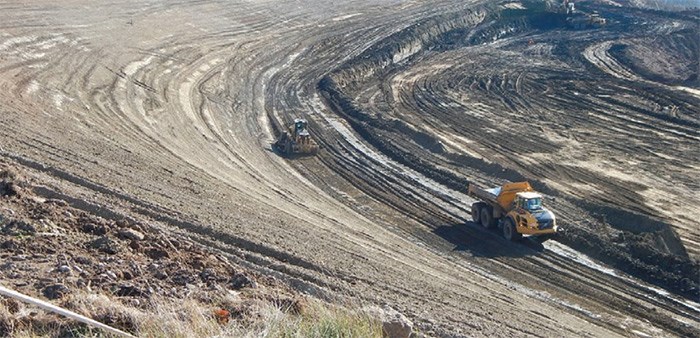 Earthmoving operations on the north bank of the Site C dam project in northern B.C. | BC Hydro
Earthmoving operations on the north bank of the Site C dam project in northern B.C. | BC Hydro
On November 1, the BC Utilities Commission (BCUC) will issue a final report that will help decide the fate of the $8.8 billion Site C hydroelectric dam project – a decision that will have long-term repercussions for B.C. business, industry and consumers.
On the line are more than 2,000 jobs and a Christy Clark legacy.
Should the project be cancelled and should the BC NDP government adopt an alternative energy portfolio suggested by the BCUC, independent power producers would likely benefit from a surge of new wind projects.
But energy-intensive industries – mines, pulp mills, cement plants – would be forced to shut down periodically, and the average BC Hydro customer might be forced to pay higher electricity rates at peak hours.
B.C. might also lose out on an opportunity to sell dispatchable power at a premium, which would not only increase Site C’s value, but also lower greenhouse gas (GHG) emissions in places like Alberta that still generate power from coal and gas, according to Marvin Shaffer, adjunct professor at Simon Fraser University’s public policy program.
The BCUC’s final report will not decide Site C’s fate, but it will guide the new NDP government on whether to proceed with a project that is 20% complete – and likely to go over budget – or cut its losses and cancel Site C.
Those losses are estimated at $3.3 billion (sunk costs and site remediation). But it will cost B.C. an additional $1.8 billion to $3.4 billion to generate or save enough power to meet future growth in power demand, according to recent BCUC estimates.
So, cancelling the project will cost $5.1 billion to $6.7 billion; completing it will cost at least $8.8 billion, and possibly up to $12 billion, according to estimates by Deloitte, if the project goes over budget.
Somewhat lost in the debate about what is more affordable – wind or hydro – is the question of what is more appropriate and what is more valuable.
Missing from the BCUC’s calculations, so far, is the net value of Site C in electricity exports, as well as greenhouse gas reductions, Shaffer said – something that would mitigate its costs, even if it went over budget.
Also missing is the cost to consumers of conservation measures like demand-side management (charging higher rates at peak hours of power demand).
Tasked with considering Site C alternatives, the BCUC produced three sample portfolios that include a mix of new wind farms, battery storage and demand-side management (energy conservation).
The three portfolios are based on BC Hydro’s low, medium and high load forecasts and range in cost from $1.8 million to $3.4 million.
New wind power totalling 444 megawatts (MW) to 591 MW would be needed. To put that in context, the largest wind farm in B.C. is the new $400 million, 185-MW Meikle project near Tumbler Ridge, which produces enough power for approximately 54,000 homes.
The BCUC has received hundreds of submissions, many of which come from groups with competing vested interests. A BC Sustainable Energy Association submission stands out, however.
Written by Mark Jaccard, a sustainable energy economist at Simon Fraser University and a former BCUC commissioner, the report takes no position on whether Site C should be scrapped or completed.
However, it warns that simple cost comparisons of intermittent renewable power to large-scale hydro are misleading and might miss a crucial point: reliable, dispatchable power is more valuable than intermittent power.
Citing Paul Joskow, a leading energy economist, Jaccard points out that intermittent power is not necessarily cheap if its levelized cost is $0.06 per kilowatt hour (kW-h) but it produces power primarily at night when the market value for electricity is just $0.02 kW-h And dispatchable power with a levelized cost of $0.25 per kW-h is not necessarily expensive if it can produce power when market values are above $0.25 per kW-h.
“The BCUC panel must take into account the differences in value provided by non-dispatchable and dispatchable generators when evaluating the claim that falling costs of non-dispatchable renewables erode the relative economic position of Site C,” Jaccard writes. “It may well turn out that the effect is the opposite.”
Shaffer agrees. Missing from the calculations of Site C’s comparative costs is its potential electricity export revenue, he said.
“It will have significant value because it’s dispatchable,” Shaffer said.
While BC Hydro’s load forecasts have been widely criticized – even by supporters of the project – for having an upward bias, Jaccard said the forecasts could turn out to be low, especially if Canada and B.C. meet their climate change targets.
He writes that BC Hydro’s load forecasts “implicitly assume that Canada and B.C. will fall far short of achieving their 2030 and 2050 GHG reduction targets.”
Should governments deliver on their climate change commitments, it could “dramatically” increase the demand for clean power, as electricity powers more electric vehicles and replaces natural gas for heating.
In Vancouver alone, which has its own climate policy in its Renewable City Strategy, the demand for electricity to replace gasoline and natural gas could increase 70% between 2020 and 2050, Jaccard estimates.
Jaccard also points to a global trend of industrial power use declining, while commercial and residential demand grow.
“And this trend can accelerate with the greater importance of footloose commercial activities, such as online services, that gravitate disproportionately to jurisdictions with relatively low electricity rates, such as B.C.
“Thus, even if it turns out that BC Hydro’s forecast continues to overestimate industrial demand to some degree, continued growth in other sectors will significantly increase electricity demand.”
nbennett@biv.com


